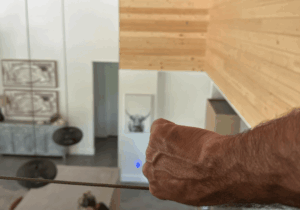Is Your Stair Railing Safe? Understanding the Critical 4-Inch Baluster Rule
As homeowners in the beautiful Flathead Valley, we cherish our homes for comfort, security, and beauty. But sometimes, the smallest details hide the biggest safety concerns. When it comes to stair railing safety, one rule stands above them all, especially for families with young children: the 4-inch baluster spacing rule!
Aaron and David frequently encounter questions about railing compliance and even find mistakes in new construction. Let’s dive into why this specific 4″ rule exists, and why it’s so crucial for your peace of mind and your family’s safety.
The Life-Saving “4-Inch Rule” for Baluster Spacing
You might have heard about it, but do you know what the 4-inch rule truly means? It’s simple, yet profoundly impactful:
No opening between balusters (the vertical posts) on a stair railing or guardrail should allow a 4-inch sphere (think of the size of a typical adult fist) to pass through.
Why 4 inches? This seemingly arbitrary measurement is specifically designed to prevent a child’s head from becoming entrapped between the balusters, a potentially tragic hazard. It’s a cornerstone of most residential building codes, including the International Residential Code (IRC), which governs much of construction in the United States.
When a 406 Home Inspection Pros inspector evaluates your staircases, this “4-inch fist test” is one of the first checks we perform.
Beyond Balusters Spacing: A Holistic Look at Stair Railing Safety
While baluster spacing is paramount, it’s just one piece of the stair railing safety puzzle. A truly safe railing system considers several other critical factors:
Railing Height: Handrails and guardrails must meet minimum height requirements (typically 34-38 inches for handrails on stairs, and 36 or 42 inches for guardrails protecting open-sided walking surfaces, depending on local codes). This prevents accidental falls.
Graspable Handrails: For safe ascent and descent, handrails must be easy to grasp. Their shape and size are often regulated to ensure a secure grip for all users.
Newel Post & Guardrail Stability: The entire railing system, from the newel posts at the ends to the balusters in between, must be securely anchored and free from wobbling. A loose railing is a dangerous railing.
Openings at the Bottom: Even if baluster spacing is correct, larger triangular openings can sometimes exist where a handrail meets a stair tread or landing. These, too, must comply with the 4-inch sphere rule.
Horizontal Balusters & Climbing Hazards: While visually appealing, horizontal baluster designs (often called “ladder effect” railings) can create a climbing hazard for children. Many codes have specific provisions or restrictions for these designs due to safety concerns.
Why Does This Matter to You, the Homeowner?
Understanding stair railing safety and the 4-inch baluster spacing isn’t just for contractors or home inspectors. It’s vital for:
Child Safety: This is the most direct and heartbreaking risk of non-compliant railings. Protecting our little ones is paramount.
Even in New, Expensive Homes: Don’t assume a new build is flawless. On a recent new home inspection, in fact a very expensive, custom home, we discovered multiple sections of railing where the baluster spacing exceeded the 4-inch rule. This highlights that even the highest-end properties can have hidden code violations, making a professional inspection crucial.
Elderly & Mobility Safety: Secure, properly designed railings are essential for stability and fall prevention for older adults or those with mobility challenges.
Property Value & Resale: A home that meets current building codes is more appealing to buyers and less likely to encounter issues during a pre-sale inspection. Safety sells!
Insurance & Liability: While rare, non-compliant safety features could potentially impact insurance claims or even liability in the event of an accident.
Peace of Mind: Knowing your home is safe and compliant allows you to relax and enjoy your living space without worry.
Is Your Railing Spaced Safely? How to Check.
 A quick DIY check can give you an initial idea: grab a 4-inch ball or make a fist and try to pass it through any opening between your balusters. If it goes through easily, your railing likely does not meet the 4-inch rule and may pose a safety risk. Also, give your railings a firm shake – do they feel loose anywhere?
A quick DIY check can give you an initial idea: grab a 4-inch ball or make a fist and try to pass it through any opening between your balusters. If it goes through easily, your railing likely does not meet the 4-inch rule and may pose a safety risk. Also, give your railings a firm shake – do they feel loose anywhere?
However, for a comprehensive assessment that covers all stair railing safety aspects and ensures full building code compliance, a professional home inspection is invaluable.
Let 406 Home Inspection Pros Ensure Your Safety—Even in New Construction!
Don’t leave the safety of your family or the value of your home to chance even if it’s brand new construction. At 406 Home Inspection Pros, we specialize in thorough, detailed home inspections that cover every critical safety feature, including precise checks of your stair railing baluster spacing, height and stability.
We provide the insights you need to make informed decisions about your property, ensuring it’s not just a beautiful place to live, but a safe one too.
Schedule your professional home inspection with us today so we can give you peace of mind that your balusters – and your entire home—is safe!
As always, we’re grateful for every one of our 300+ 5-star reviews and even more grateful for your referrals.
